Lodges in the Province of Bristol
Masonry, or Freemasonry as it's often referred to in the UK, is split into geographical provinces. Each province then has a number of lodges that meet on different days of the week. Membership to a lodge is sometimes linked to a profession or interest such as scouting, sport, hospitality or even university.
In Bristol we have 37 lodges, with the oldest dating back to 1758, each with it's own unique and sometimes interesting traditions. Below is a list of our lodges but if you're interested in finding the best lodge for you, why not arrange to visit us on one of our regular information evenings.
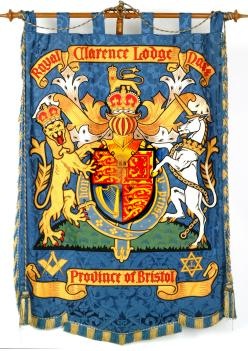
The Royal Clarence Lodge
Warranted on the 14th September 1807 and granted a Centenary Warrant in 1907, the Royal Clarence Lodge meets on the second Monday in each month (except for June, July and August) and holds its Installation at the December meeting.
The lodge is a daughter of Jerusalem Lodge No. 162 (an Antient lodge which was erased in 1829) and was first named as the Mariners Lodge No. 72, chosen as a compliment to the seafaring brethren amongst the founders.
The first reference of “Royal” appeared in 1809 with an advertisement in the Bristol Journal headed “Royal Mariners Lodge No. 72” giving details of the charitable sums available to distressed Antient Masons. No other mention of “Royal” appeared until 1820, after which the minute entries are headed Royal Mariners.
In December 1817, the lodge agreed that a letter should be sent to H.R.H. the Duke of Clarence requesting permission to attach the title of “Royal Clarence” to that of “Mariners”. Three days later, the lodge received the Duke’s reply stating the request had his entire approbation.
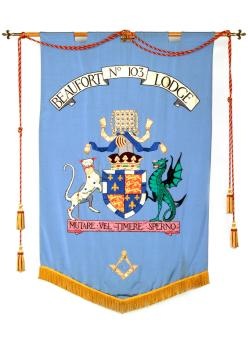
The Beaufort Lodge
Warranted on the 8th March 1758 and granted a Centenary Warrant in 1874, the Beaufort Lodge meets on the first Tuesday in each month (except for June, July, August and September) and holds its Installation at the October meeting. Although the oldest lodge in the Province, numerically the lodge ranks second to the Royal Clarence Lodge, where seniority was decided by the re-numbering of lodges at the union between the ‘Ancients’ and the ’Moderns’ in 1813.
The lodge originally met at The Bell in Broad Street, later moving to The Guinea in Small Street, and then in 1765 removed to the ‘Duke of Beaufort’ on the Quay.
At this time the adoption of distinctive titles had commenced and in 1771 the lodge was named “The Beaufort”
The lodge banner bears the arms of the Duke of Beaufort and has the motto ‘Mutare Vel Timere Sperno’ which translates to ‘I scorn to fear or to change’.
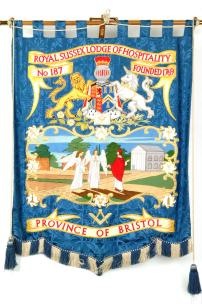
The Royal Sussex Lodge of Hospitality
Warranted on the 12th August 1769 and granted a Centenary Warrant in 1874, the Royal Sussex Lodge of Hospitality meets on the second Wednesday in each month (except for July, August and September) and holds its Installation at the October meeting. The Lodge originally met at the Shakespeare Tavern in King Street, Bristol. Although its roots can be traced further back to the Bush Lodge of 1740 having being named after their meeting place, which was custom in that period.
The lodge became the Royal Sussex Lodge of Hospitality in April 1814 after receiving royal patronage from the Duke of Sussex, the 6th son of King George III, and the then Grand Master. Sadly there is no record of the Duke ever actually visiting Bristol or the lodge.
The lodge received its bi-centennial warrant on 22nd October 1969, and in its long history has produced four Provincial Grand Masters and seven Deputy Provincial Grand Masters.
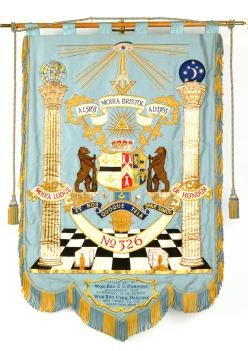
The Moira Lodge of Honour
Warranted on the 5th April 1809 and granted a Centenary Warrant in 1909, the Moira Lodge of Honour meets on the first Wednesday in each month (except for January, June, July and August) and holds its Installation at the December meeting. The Lodge has a rich history. It was named after Francis Rawdon, the Second Earl of Moira who was acting Grand Master at the time of its consecration. The name Francis Rawdon and Moira are very much revered by the members of the lodge and after joining, new members soon realise the important heritage and history associated with the lodge and this outstanding man.
Francis Rawdon, was a peer in the realms of England, Scotland and Ireland as well as being a member of the House of Lords and also, of the Irish House of Commons.
In March 1823, whilst serving his appointment as Governor of Malta, his health broke down and when en route to Naples for treatment in 1826, he died on board H.M.S. REVENGE. His remains were returned to Malta where he was buried. His tomb is situated in Hastings Gardens on St Johns Bastion, at Valetta and has in fact been visited by several current members of the lodge.
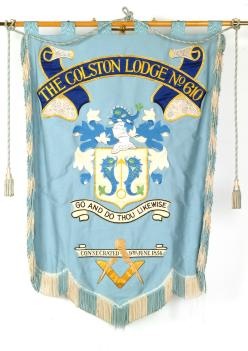
The Colston Lodge
Warranted on the 28th February 1853 and granted a Centenary Warrant in 1954, the Colston Lodge meets on the third Wednesday in each month (except for June, July and August) and holds its Installation at the September meeting.
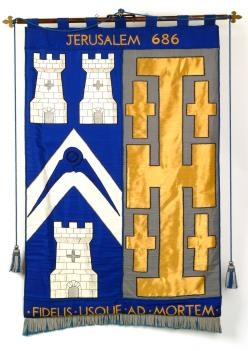
The Jerusalem Lodge
Warranted on the 10th October 1856 and granted a Centenary Warrant in 1956, the Jerusalem Lodge meets on the second Tuesday in each month (except for May, June, July, August and September) and holds its Installation at the February meeting.
Jerusalem being the cradle of Masonry, it is perfectly understandable that the founders of the Bristol Jerusalem should decide to perpetuate the name, to serve as a regular reminder to the Brethren of the lodge.
There had been two previous Jerusalem Lodges, one belonging to the Modern Grand Lodge which was consecrated in 1767 but erased in 1769, and one belonging to the Antient Grand Lodge which was founded in 1769 but erased in 1829.
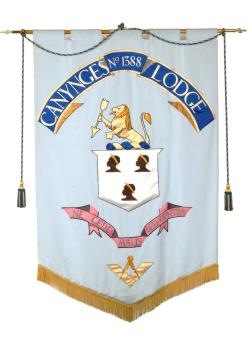
The Canynges Lodge
Warranted on the 16th December 1871, Consecrated on the 4th March 1872 and granted a Centenary Warrant in 1972, the Canynges Lodge meets on the first Saturday in each month (except for June, July, August and September) and holds its Installation at the March meeting.
A small number of commercial travellers being Bristol Masons unable to attend lodges mid-week, decided to take appropriate steps to remedy this. Accordingly, Canynges Lodge was formed under the sponsorship of the Jerusalem Lodge.
The lodge was the first to be consecrated at Freemasons’ Hall, Park Street; the hall itself having been dedicated only one month before this.
The name derives from the wealthy merchant family of Canynges who had long been leading benefactors in Bristol. There is evidence that William Canynges was a patron of a fraternity of operative masons engaged in rebuilding St. Mary Redcliffe Church after its almost complete destruction by lightning in 1445 and that in 1460, when Mayor of the City, he re-erected the ruined St, Mathyas Chapel in Redcliffe to serve as a Freemasons’ Hall.
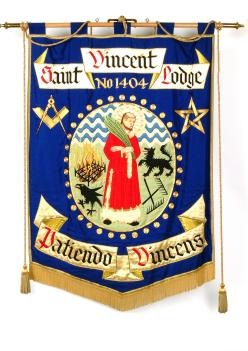
The St Vincent Lodge
Warranted on the 13th June 1872 and granted a Centenary Warrant in 1972, the Saint Vincent Lodge meets on the fourth Thursday in each month (except for June, July, August and December) and holds its Installation at the October meeting. The lodge owes its origins to the vision of one man, a solicitor, Lieutenant-Colonel James Roger Bramble F.S.A. (1841-1908), who assembled together a number of like-minded men including members of the famous family of Bristol wine merchants, the Harveys and petitioned for a new lodge, which was sponsored by the Beaufort Lodge. The Patron Saint, St Vincent of Saragossa, was probably chosen on account of the association of his name with the Clifton Rocks, although there is considerable uncertainty over this and many possible reasons for the Lodge’s name have been discussed.
St. Vincent was a Spanish deacon who, in AD 304, was thrown into prison with his Bishop, Valerius of Osee, in Granada by Dacian, the Governor of Spain, under the edicts of the Emperors Diocletian and Maximian. St. Vincent was tortured first upon the rack, and then by fire upon a gridiron and by many other torments, but his constancy remained unshaken and he was taken back to prison where he died. Dacian commanded that his body be thrown on a marshy field among the rushes, but it is recorded that a crow defended the body from wild beasts and birds of prey.
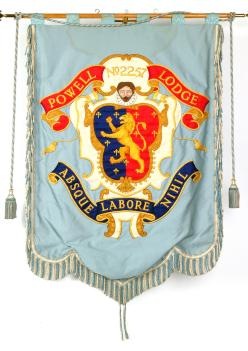
The Powell Lodge
Warranted on the 1st August 1928 and Consecrated on the 24th August 1928, the Semper Fidelis Lodge meets on the second Wednesday in each month (except for June, July, August and September) and holds its Installation at the December meeting.
Originally conceived by Devonian Freemasons in Bristol and sponsored by The Powell Lodge for approval by Grand Lodge; Semper Fidelis Lodge has enjoyed a rich and fruitful existence and still toasts The Powell Lodge at their Installation meeting in December as a mark of respect to their ‘mother lodge’. The Powell Lodge is still very supportive and maintains close links to its ‘daughter lodge’.
More recently in April 2023 Semper Fidelis Lodge has decided to rebrand itself as the natural home for uniformed services making it Bristol’s ‘special interest military lodge’. The Lodge still holds dear the traditions built up over nearly 100 years, but is now adding to them from a military aspect.
Semper Fidelis Lodge welcomes new members from any background, but those with links to the military will find a familiar home and a unique experience
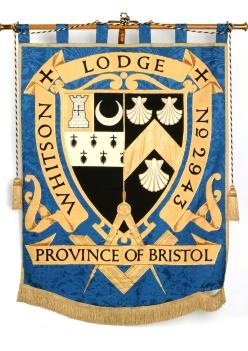
The Whitson Lodge
Warranted on the 27th October 1902, the Whitson Lodge meets on the third Saturday in each month (except for June, July, August and September) and holds its Installation at the February meeting.
Formed entirely by members of Canynges Lodge, the Whitson Lodge was the second lodge to be formed in Bristol for the convenience of those who could best attend on Saturdays.
The lodge is named after John Whitson, an influential merchant who lived on Nicholas Street, Bristol during the sixteenth and seventeenth century. During his lifetime, he was elected four times as M.P. for Bristol, twice Mayor and twice Master of the Society of Merchant Venturers, keenly supporting voyages of exploration.
Widely known as a man of large charity, a great friend of the poor, and the founder of the Red Maid’s School, John Whitson died at the age of seventy-one through a fall from his horse and was buried in the Crypt of St. Nicholas where his tomb can still be seen.
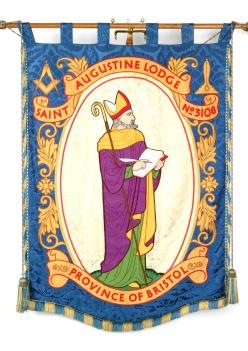
The St Augustine Lodge
Warranted on the 15th April 1905 and granted a Centenary Warrant in 2005, the St Augustine Lodge meets on the second Thursday in each month (except for January, June, July and August) and holds its Installation at the September meeting. The lodge was established as a musical lodge, the name chosen by the Founders due to the neighbourhood of Freemasons’ Hall being closely associated with St Augustine.
An Augustinian Priory formally stood on the site of Bristol Cathedral. The Cathedral (dedicated to the Holy Trinity in 1542), was until 1539 the Abbey Church of the Black Canons of St Augustine. Further, St Augustine of Canterbury is said to have preached on College Green prior to his conference with the Bishops of the early British Church in the late sixth century.
The Consecration Ceremony was attended by 238 brethren and conducted by W.Bro. JR Bramble the Deputy Provincial Grand Master and W.Bro. J Mason Gutteridge who had been the Master of the Beaufort Lodge and who became the first Master of the new Lodge.
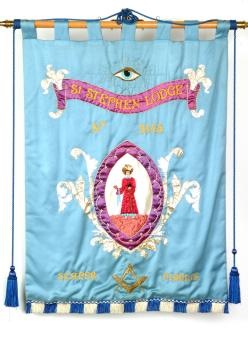
The St Stephen Lodge
Warranted on the 6th January 1906, the St, Stephen Lodge meets on the third Monday in each month (except for June, July, August and September) and holds its Installation at the March meeting.
In October 1905, it was felt that there was room for another lodge in the province, and after some preliminary meetings of the brethren interested, a petition was signed for the constitution of a new lodge to be called St. Stephen.
All the founder brethren below the Chair were drawn from the Colston Lodge and those founder brethren who had passed the Chair were, with one exception, members of the Royal Clarence, Royal Sussex, Moira, Jerusalem, Canynges, St. Vincent and Powell Lodges, and that is why it can be said that St. Stephen Lodge is not the child of any particular Lodge, but of the Province in general.
The figure of the saint, as it appears on the Lodge summons, is copied from the ancient Silver Seal of the Parish of St. Stephen, which is believed to have been worn on state occasions, and his badge of office, by every Rector since the 14th century
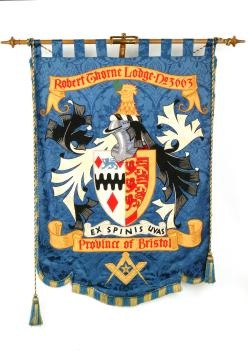
The Robert Thorne Lodge
Warranted on the 16th April 1913, the Robert Thorne Lodge meets on the second Saturday in each month (except for June, July, August and September) and holds its Installation at the October meeting.
The Founders of the Robert Thorne Lodge comprised of ex-pupils of Bristol Grammer School, and a large part of its membership came from that source.
The lodge is named after Robert Thorne, a Spanish oil merchant, soap maker and a wealthy member of the woollen trade in Bristol. He was a descendent of Rollo, the Duke of Normandy, was mayor of Bristol in 1515 and M.P. for Bristol in 1523. I was his desire to found a free grammer school in Bristol which would continue forever. However, before his dreams came to fruition, he died leaving a large estate in which provisions were made for the school.
His sons, Robert Thorne Jnr and Nicholas Thorne carried on his legacy, and became Founders of the Bristol Grammer School.
The memory of Robert Thorne is honoured at the lodge’s after-meeting in a toast called “The Pious and Immortal memory of Robert Thorne”, coupled with the rendering of the school song.
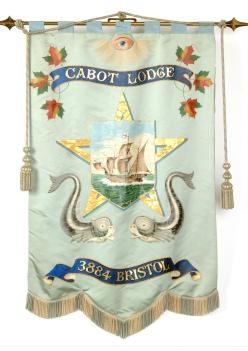
The Cabot Lodge
Warranted on the 4th September 1918, the Cabot Lodge meets on the second Friday in each month (except for May, June, July, August and September) and holds its Installation at the January meeting. The lodge was named after John Cabot (Giovanni Cabotti) a famous, Italian, nautical explorer who sailed from Bristol, funded by Bristol merchants, for the New World on 2nd May 1497, sighting Cape Bonavista on the Newfoundland Coast 34 days later. There are many memorials to Cabot in Bristol, the Cabot Tower on Brandon Hill and a replica of his ship the “Matthew” in the docks, amongst others.
The Canada Lodge in London donated the first banner for the Consecration Ceremony. The lodge was instrumental in founding the Bristol Lodge, London in 1933 where there are still strong connections with both of Lodges and make regular Fraternal Visits.
It is believed that the original raison d’etre of the Lodge was for members of the engineering profession.
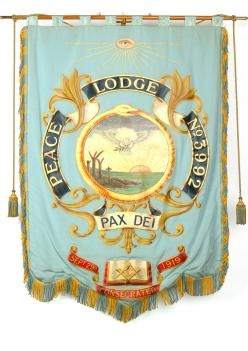
The Peace Lodge
Warranted on the 22nd July 1919 and Consecrated on the 29th September 1919, the Peace Lodge meets on the first Friday in each month (except for June, July, August and September) and holds its Installation at the October meeting. The idea of forming the Peace Lodge arose from growing membership within The Royal Clarence Lodge, with 180 brethren plus 20 candidates on the waiting list.
The initial discussions of a Daughter lodge took place in 1914, but as the demands of the Great War caused masonic activity to diminish, it was late in 1918 before the idea was revived.
These initial meetings were followed by the formation of a Working Party wherein decisions were reached on the Conditions of Founding, the method of selecting the Founder members, the Founders Fees, dates of Lodge meetings and the Annual dues.
By the end of May 1919, 28 Founders had signed and 4 more had promised. Worshipful Brother George Canvin was chosen as the first Worshipful Master of the Lodge, and the supporting officers were chosen according to their seniority.
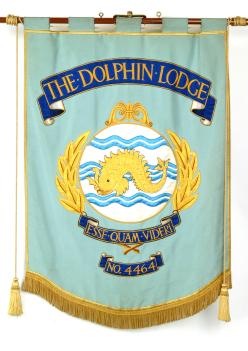
The Dolphin Lodge
The history of Dolphin Lodge (No.4464) begins with the consecration of the Beaufort Lodge (No. 103) in 1758, the second oldest Lodge in the Province of Bristol. When a daughter lodge, The Colston Lodge (No. 610) was formed in 1853 it was only the fifth Lodge in the Province. Such was the popularity of the Craft after the Great War that another seven lodges were Consecrated in the 10 years to 1928. The Brethren of Colston Lodge were concerned at the long time it took to progress to the Chair so they formed The Dolphin Lodges in 1922 but the most junior founder still took 11 years to become Worshipful Master and during the 1940’s and 1950’s that period had extended to over 20 years for new members.
There have been many examples of outstanding service to the Lodge such as the Founding Secretary ( W.Bro. Walter Booker) who died, still in office, 22 years after the Consecration. W.Bro Sam Crabbe, the longest serving/Life Member was still in regular contact with the Lodge 64 years after his initiation, when he died just short of his 110th birthday. The Quick family provided six masters during a period of membership covering 80 years and W.Bro John Jones still provides a direct link to three of the Founders who were Members when he was initiated in 1964. Probably unique for Bristol , the Lodge once numbered an Archbishop amongst its members when a pre-war Chaplain, by then an Honary Member, Bro. Leslie Vinning was appointed to See in West Africa in 1951. On the 100th Anniversary of the Consecration of the Lodge we witnessed a first for the Lodge when W. Bro. Ian Jarmaine installed his son Matthew in The Chair of King Solomon. During its second 50 years the Lodge has been honoured by the appointment of Rt. W.Bros J.G.J Mickleburgh, A.J Vaughan and J.M.W Davis to serve as Provincial Grand Master for Bristol. Their stories and those of our other brethren and of the 743 meeting which we have had contributed to the life of the Lodge for the first 100 years and have been recorded in a History prepared for the centenary celebration in 2023.
The Lodge was the last one to meet in the old Park Street Masonic Hall before it was destroyed by German bombing in November 1940. Although many of the Lodge records from 1922 onwards were lost as a result of this devastation, Summons and Annual Accounts have survived for all of this period. From these we see that the Lodge was on a very sound financial footing from the outset and also, how during the first 60 years, charitable donations were directed almost exclusively to Masonic causes. Although our early forbears partook of simple fare at most after-meetings, following an Installation Meeting they enjoyed a veritable banquet with wine and cigars included. Te deprivations of the Second World War put a stop to such excesses and financial pressures in the second half of the 20th century precluded any return to such fine dining.
In common with other Lodges, Dolphin was to meet in a number of other venues in and around Bristol for the next 17 year. Prior to the opening of the new Park Street building in 1957, father and son Dolphin Members , Bro. Ernest and W.Bro William Paisley, who had a joinery business in the City, were responsible for much of the paneling and Lodge furniture we enjoy to this day. After the return to the new hall in 1957 the life of the Lodge settled into a much more orderly pattern. Although relatively well supported throughout the next two-thirds of it’s existence, membership never again reached the peak of 118 in 1950. From the 1960’s there has been a continuing downward trend until currently. We have around half of that 1950 figure. That’s not stopped the Lodge from being successful over the years in raising monies for both Masonic and non-Masonic causes whilst enjoying good fraternal Fellowship.
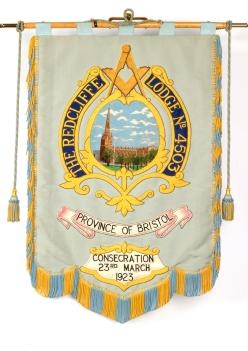
The Redcliffe Lodge
Warranted on the 18h December 1922 and Consecrated on the 23rd March 1923, the Redcliffe Lodge meets on the fourth Friday in each month (except for May, June, July, August and December) and holds its Installation at the April meeting. There were 19 founders of the Lodge, all of whom were members of Canynges Lodge. There is evidence that William Canynges the younger was a patron of a fraternity of operative masons engaged in rebuilding St. Mary Redcliffe Church after its destruction by lightning in 1445.
The name selected by the petitioners for their daughter lodge continued the association (however tenuous) with the church.
Worshipful Brother W.R. Morgan was chosen as the first Master of the lodge. The first joining member of the lodge was Brother F. Clarke who later went on to become Provincial Grand Secretary.
There has been a long standing tradition of fraternal visits to Albert Edward, Prince of Wales Lodge No.1429 in Newport. The first series of visits took place in 1937. After a lapse of many years they resumed in 1962 and have continued annually to the present day.
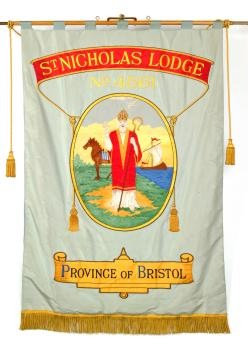
The St Nicholas Lodge
Warranted on the 17th September 1923 and Consecrated on the 5th January 1924, the St. Nicholas Lodge meets on the last Saturday in each month (except for June, July, August and December) and holds its Installation at the September meeting.
Sixteen members of the Whitson Lodge petitioned for the warrant to form St. Nicholas Lodge, as like Whitson, the new lodge would be formed for the convenience of those who could best attend on a Saturday.
Fourteen of the founders were commercial travellers as were many of the early members. The name, St Nicholas, was particularly appropriate, therefore being the patron saint of “merchants and travellers by sea and land”.
The main reason for the choice of name, however, came from the association of Whitson Lodge with St. Nicholas Church were John Whitson, the famous Bristol merchant and benefactor is buried.
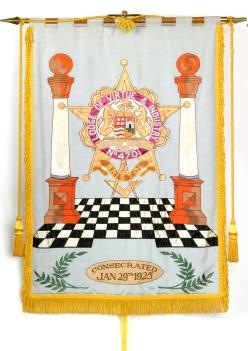
The Lodge of Virtue and Industry
Warranted on the 3rd December 1924 and Consecrated on the 29th January 1925, the Lodge of Virtue and Industry meets on the third Friday in each month (except for June, July, August and September) and holds its Installation at the March meeting.
The majority of the petitioners to form this lodge came from the members of the Beaufort Lodge. Deciding on a name for the new lodge provided a certain amount of difficulty but “Virtue and Industry” was finally chosen.
The ceremony of consecration, which took place on Friday 29th January 1925, was performed by the Very Worshipful Brother, the Deputy Provincial Grand Master Sir Ernest H Cook PGD. of England.
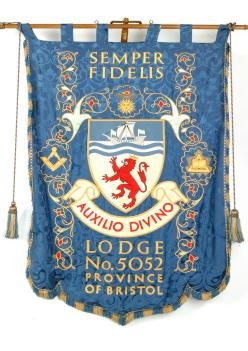
The Semper Fidelis Lodge
Warranted on the 1st August 1928 and Consecrated on the 24th August 1928, the Semper Fidelis Lodge meets on the second Wednesday in each month (except for June, July, August and September) and holds its Installation at the December meeting.
Originally conceived by Devonian Freemasons in Bristol and sponsored by The Powell Lodge; Semper Fidelis Lodge has enjoyed a rich and fruitful existence and still toasts The Powell Lodge at their Installation meeting in December as a mark of respect to their ‘mother lodge’. The Powell Lodge is still very supportive and maintains close links to its ‘daughter lodge’.
More recently in April 2023 Semper Fidelis Lodge has decided to rebrand itself as the natural home for uniformed services making it Bristol’s ‘special interest military lodge’. The Lodge still holds dear the traditions built up over nearly 100 years, but is now adding to them from a military perspective.
Semper Fidelis Lodge welcomes new members from any background, but those with links to the military will find a familiar home and a unique experience.
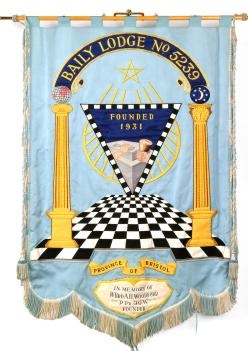
The Baily Lodge
Warranted on the 27th October 1930 and Consecrated on the 24th February 1931, the Baily Lodge meets on the fourth Tuesday in each month (except for June, July, August and December) and holds its Installation at the September meeting. In 1930, the Royal Clarence Lodge had a membership of just over 200 and a long list of candidates. Despite the fact they had already founded the Peace Lodge, it was thought desirable to form a second new lodge.
Several meetings took place to discuss the new project, and all agreed the new lodge would be called the St. John Lodge. This was submitted to the Most Worshipful Grand Master, but for some unknown reason the name did not find favour.
An abortive appeal took place and a meeting was called for a new name – W Bro. Baker suggested the name ‘The Baily Lodge’
Edward Hodges Baily was a son of a Bristol ship carver. He was a famous sculptor of his time and was responsible for many famous busts and statues. He won several medals, but his “Eve at the Fountain” now in the Bristol Art Gallery, first established his reputation.
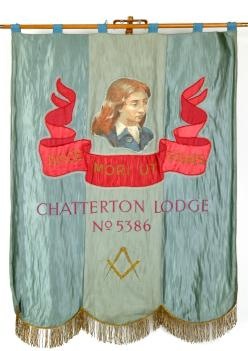
The Chatterton Lodge
Warranted on the 2nd November 1932 and Consecrated on the 17th January 1933, the Chatterton Lodge meets on the first Thursday in each month (except for January, June, July, August and September) and holds its Installation at the May meeting. As a daughter lodge of the Canynges lodge, the name ‘Chatterton’ was chosen to commemorate the famous boy poet, Thomas Chatterton.
The Latin motto ‘Disce Mori ut Vivas’ (Learn to die so that you might live), was most appropriately adopted for the Lodge Banner and Crest.
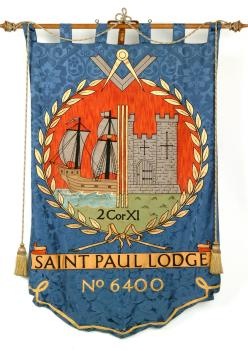
The Saint Paul Lodge
Warranted on the 4th December 1946 and Consecrated on the 8th March 1947, the Saint Paul Lodge meets on the third Friday in March, May, December and fourth Friday in October, and holds its Installation at the May meeting.
It may come as a surprise to many to learn the Thomas Dunckerley was instrumental in starting the move which resulted in the naming of St Paul Lodge. Further action in 1910 by Bro. Powell and Littleton provided the next step towards action.
In 1789, Dunckerley laid the foundation stone of St Paul’s Church on Portland Square with “masonic honours”.
The fact that Dunckerley laid the stone and that Powell and Littleton included the occasion in Freemasonry in Bristol resulted in a founder recollecting “St. Paul’s Church and Masonic Honours” and this eventually resulted in the adoption of the sacred name of St. Paul.
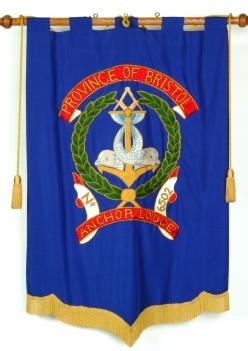
The Anchor Lodge
Warranted on the 7th May 1947 and Consecrated on the 18th June 1947, the Anchor Lodge meets on the first Wednesday in each month (except for January, July, August and September) and holds its Installation at the June meeting.
The founders of the Anchor Lodge were all members of the Colston Lodge.
The founders wished to adopt a name which would be unique to the lodge, yet at the same time identify its close association with its mother lodge, Colston, and also its sister lodge, Dolphin – Anchor was the happy and apt outcome.
The choice of Anchor symbolises safety and security.
The crest of the Lodge features an anchor, together with two dolphins – the dolphins represents its mother and sister lodge.
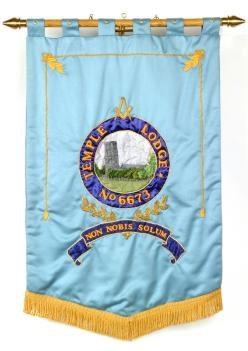
The Temple Lodge
Warranted on the 5th May 1948 and Consecrated on the 7th July 1948, the Temple Lodge meets on the first Friday in February, March, April, May, June, November, December and the fourth Friday in September, and holds its Installation at the September meeting.
Founded by twenty-five members of the Redcliffe Lode, it was natural that the daughter Lodge’s name should be associated with Temple Church whose parish adjoined Redcliffe.
The wardens’ columns of the Lodge were made from timber of the ruined Temple Church and presented by the first wardens of the lodge.
The Lodge first met at the Hawthorns Hotel annexe and later at Brunswick Square. It was not until 1957 when W Bro. Strachan, the last of ten founders to reach the Chair, was installed, that the Lodge was able to meet at the newly rebuilt Freemasons’ Hall on Park Street.
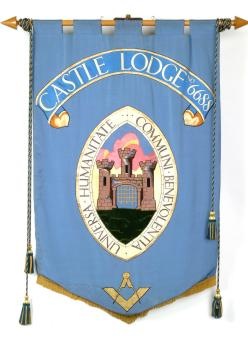
The Castle Lodge
Warranted on the 5th May 1948 and Consecrated on the 14th July 1948, the Castle Lodge meets on the third Tuesday in each month (except for June, July and August) and holds its Installation at the September meeting.
Castle Lodge 6688 is a young vibrant Lodge within the Province of Bristol. Castle Lodge has a distinctive membership identity, with a good proportion of its members being from the entrepreneur and small business owner walks of life, from such diverse sectors such as Technology, Construction, Recruitment, Distilling, and more.
At Castle Lodge, we aim to uphold the highest standards of Masonic Ritual, providing, as much as possible, a profound and enriching experience for our members. Beyond this ceremonial aspect, our lodge prides itself on fostering a close-knit community where brethren regularly meet and gather for social activities, forging strong bonds of friendship and support.
In line with our entrepreneurial spirit, Castle Lodge looks to enable its members to share ideas and experiences from their lives in the spirit of helping each other. Castle Lodge believes in nurturing not only the spiritual and fraternal aspects of Freemasonry but also in facilitating personal growth and above all friendships.
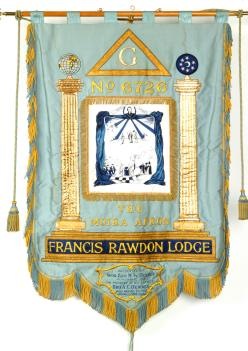
The Francis Rawdon Lodge
Warranted on the 28th July 1948 and Consecrated on the 8th September 1948, the Francis Rawdon Lodge meets on the third Monday in each month (except for May, June, July, August and September) and holds its Installation at the April meeting. [further detail to follow]
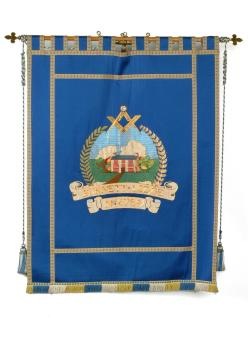
The Burnett Lodge
Warranted on the 28th July 1948, Consecrated on the 21st December 1948, and re-dedicated as a “Daylight” lodge on the 14th May 2015, the Burnett Lodge now meets at 11.00am on the first Thursday in March, May, December and the second Thursday in September, and holds its Installation at the December meeting.
Being another daughter to the Whitson Lodge, the Lodge name was chosen as John Whitson lived at Burnett House in the village of Burnett.
Burnett House forms feature of the Burnett Lodge Crest which appears on the lodge banner.
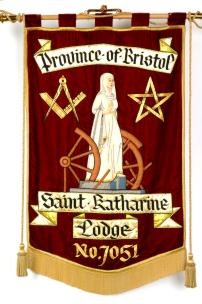
The St Katharine Lodge
Warranted on the 6th December 1950 and Consecrated on the 18th January 1951, the Saint Katharine Lodge meets on the second Tuesday in January and the first Tuesday in February, March, April, May, October, November and December, and holds its Installation at the February meeting. [further detail to follow]
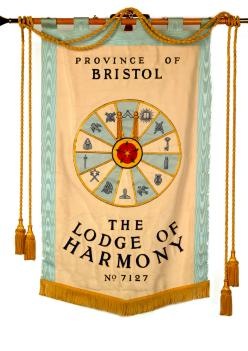
The Lodge of Harmony
Introduction
Welcome to the Lodge of Harmony 7127—a modern Freemasons lodge where tradition meets fellowship, community impact, and a vibrant social calendar. We provide a welcoming environment for like-minded individuals to connect, grow, and make a difference.
History
Established in 1951 by request of members of Round Tables based in Bristol and
consecrated on January 10, 1952. The Lodge of Harmony has a proud heritage of upholding Bristol Masonic Rituals. Over the decades, we’ve stayed true to the principles of Freemasonry, fostering strong bonds among members while contributing to the wider community and maintaining links with Round Tables, other service clubs such as Rotary and Lions and Round Table Lodges.
Activities and Timings
We meet7 times per year on the second Thursday from January to May and October and November, with an Installation in January—a formal yet enjoyable event to appoint new officers—being the highlight. Gatherings combine meaningful rituals, lively dinners, and social events, alongside opportunities to support local and national charitable causes. Adopt, Adapt, Improve.
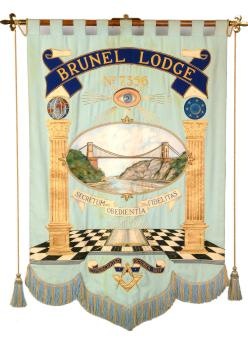
The Brunel Lodge
In 1953, when in many Bristol Lodges the progress to the Chair seemed to many younger masons a very long process, Worshipful Brother Cecil Waddington had the belief that a Lodge of Engineers would add a new dimension and extra lustre to the Bristol Masonic scene and he pursued this objective with great vigour.
This vision of progression and critical thinking set by our founders is continued today within Brunel Lodge. Like that of our namesake, we strive for innovation and perfection. We pride ourselves supporting Bristol and building a better future. Brunel accepts members from all walks of life, and we seek Brethren who wish to build on their own knowledge.
Brunel Lodge: Warranted on the 28th July 1954 and Consecrated on the 21st October 1954, the Brunel Lodge meets on the third Thursday in each month (except for April, June, July, August and December) and holds its Installation at the November meeting.
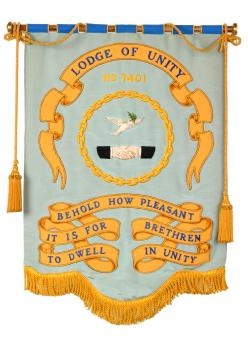
The Lodge of Unity
Warranted on the 4th May 1955 and Consecrated on the 18th October 1955, the Lodge of Unity meets on the third Thursday in January and the first Thursday in March, April, May, June, October, November, December, and holds its Installation at the November meeting. The Lodge of Unity was conceived at a meeting of 14 brethren from Peace Lodge. The reason this step was taken was then explained to the meeting that an initiate into Peace Lodge may have to wait 20 years before reaching the Chair. It was then stated that 21 members had shown an interest in the formation of a new Daughter Lodge.
Further meetings were held where names were put forward for the Lodge such as, St Barnabas Lodge, St Christopher, and Durdham, but it was suggested by the then PGM the Right Worshipful Brother George Tryon, at another meeting the name’ Lodge of Unity’ but it was stressed that it was only a suggestion. This name was then readily adopted. Following the adoption of the Lodge of Unity name it was proposed that a Lodge motto be proposed and Psalm 133 fitted the bill, ‘Behold, how good and how pleasant it is for Brethren to dwell together in Unity’
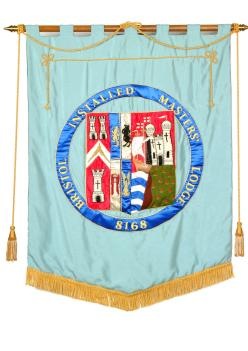
Bristol Installed Masters' Lodge
Warranted on the 8th March 1967 and Consecrated on the 3rd May 1967, the Bristol Installed Masters’ Lodge meets on the fourth Wednesday in May and the last day of October (not being a Saturday or Sunday), and holds its Installation at the May meeting.
The lodge represents the greatest accumulated experience in the whole of the Province. Its name is self-explanatory and needs no further description except to quote from the Lodge By-laws;
“The Lodge is formed for the association of subscribing members of Lodges in the Province who are serving or have served the Office of Master of a Lodge in the Province of Bristol under the Grand Lodge of England”
Membership of the Lodge is a unique privilege, one that every Master or Past Master of a Bristol Lodge should not fail to accept.
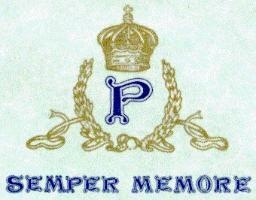
The Bristol Patrons Lodge
Warranted on the 9th June 1993 and Consecrated on the 16th October 1993, the Bristol Patrons Lodge meets on the last Thursday in September and March (at noon), and holds its Installation at the September meeting. [further detail to follow]
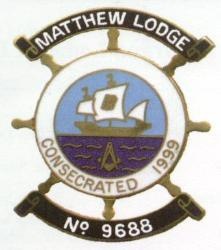
The Matthew Lodge
Warranted on the 11th November 1998 and Consecrated on the 20th February 1999, the Matthew Lodge meets on the fourth Saturday in February, the first Saturday in June, the second Saturday in October and the first Saturday in December, and holds its Installation at the February meeting.
What makes the Mathew Lodge so unique?
The clues are contained within their statement ‘Embracing Masonry, Family and Friends’.
The decision to meet on a Saturday morning was a deliberate decision designed to accommodate the second and most unique feature of the lodge – non Masons dine with the members at all of the after-meetings. This means that wives, partners and family are able to join and celebrate the Masonic occasion. Recently, four generations of one family were present. Everyone is made to feel most welcome.
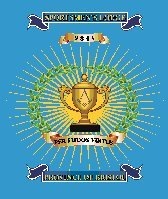
The Sportman's Lodge
Consecrated on the 20th September 2008, the Sportsmen’s Lodge meets on the fourth Thursday in February, the third Thursday in April, the second Thursday in June, the third Monday in September and the third Thursday in December, and holds its Installation at the April meeting.
The Lodge was formed for the association of subscribing and Honorary Members of lodges in the Province of Bristol and adjacent Provinces to bring together Sport’s minded people to share a common interest under the United Grand Lodge of England.
The Lodge is a working one with many new candidates having been initiated during its short history. The Provincial Grand Master R.W Bro Alan John Vaughan having been its first Worshipful Master.
None Masons are invited at one of the Meals to listen to a guest speaker of the sporting world which has proved very successful in promoting the Lodge.
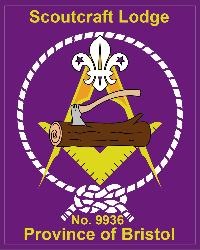
The Scoutcraft Lodge
Consecrated on the 29th April 2017, the Scoutcraft Lodge meets on the second Saturday in February and April, and the third Saturday in October and November, and holds its Installation at the April meeting.
The newest addition to the Province’s roll of lodges, the lodge was created with 29 Founder Members, the majority of which are actively involved in the Scout Movement.
There are many parallels between Scouting and Freemasonry. The two organisations are built around similar values and are essentially working towards a similar goal – to make us better people.
The Lodge meets on Saturday mornings – wives, partners, family, friends and prospective candidates are invited to the aftermeeting meal following the November meeting, and Scout Uniform will be worn by members at the February meeting.
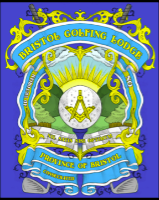
Bristol Golfing Lodge
Consecrated on the 30th of November 2019, the Bristol Golfing Lodge The Lodge shall meet at the Freemason’s Hall, Park Street, Bristol. BS1 5NH and holds regular meetings on second Tuesday in May; third Tuesday in June; first Tuesday in September and the fourth Tuesday in October, at 6.30pm.
The Golfing Lodge also plays golf at a venue close to the Lodge meeting from 10.30am on the day of each meeting.
The Lodge was formed from the association of subscribing and Honorary Members of lodges in the Province of Bristol and adjacent Provinces to bring together Golfers to share a common interest under the United Grand Lodge of England.
The Lodge is a working one with new candidates being initiated during its short history. The Past Provincial Grand Master R.W Bro Alan John Vaughan having been its first Worshipful Master. Non-Masons are invited to join us at any of the golf competitions played prior to a lodge meeting
